Print the PDF
Functional Behavior Assessment (FBA) Guide and Checklist
What is a Functional Behavior Assessment?
A Functional Behavior Assessment (FBA) is an assessment tool used to understand the reasons behind a student’s behaviors. It provides important information for parents, caregivers, and educators. FBAs help identify the root causes of the behaviors and what to teach students to do instead. They assist the team in identifying interventions that will help the child learn.
How can an FBA be helpful?
Defines the behaviors:
The first step in the FBA process is to clearly define the behaviors. This should include factual, observable statements. The team should consider what the child’s behaviors look and/or sound like. It is important to describe the behavior in enough detail so that anyone working with the child can recognize it. Information about how often the behavior(s) occur, and/or how long they last, may be included. The description should include examples and non-examples of the behavior. When the behaviors are clearly defined, they can be observed and measured.
| Category |
Definition of Behavior |
Measure |
| Physical Aggression |
Behaviors that result in forceful physical contact with another individual.
Examples: hitting with a closed fist, kicking
Non-examples: “fist bumps,” kicking a ball in PE class |
Frequency |
Explains the “why”:
Another important part of the FBA is that it can help explain the root cause of the behavior, or why the student behaves the way they do. This is called the hypothesized function. Possible functions are: attention, escape, tangible, and automatic.
1. Attention: gain attention from an adult or peers
2. Escape: leave a non-preferred environment or task
3. Tangible: gain a preferred object or more time with an activity
4. Automatic (sensory): seek a preferred sensation, or relief from discomfort
A behavior can have more than one function. This is called a dual function. Finding out why a child behaves a certain way can help the team create a plan that meets the child’s needs more effectively and appropriately.
Drives the Behavior Intervention Plan (BIP):
After completing an FBA, the team may recommend creating accommodations or a Behavior Intervention Plan (BIP). The information in the FBA is used to develop a BIP. The BIP helps by preventing challenging behaviors, responding to behaviors in a consistent and planned way when they happen, and teaching new, positive behaviors.
When is an FBA needed?
According to Iowa IDEA Information (i3),
1. An FBA may be done for any child with a behavior concern. This will help the team understand why the child is behaving a certain way and create a plan to support them better.
2. An FBA should be completed for any child in special education with a behavior concern. This helps to develop a behavior goal or BIP. If a child has an FBA and BIP, but the plan is not working as expected, the team could consider conducting another FBA with more detail.
3. An FBA must be completed, or reviewed, for any child with an IEP who is removed from their regular setting because of behavior for:
• more than 10 days in a row; or
• more than 10 school days in a school year for separate, similar incidents that show a pattern
• AND a manifestation determination meeting has been held, and the team decided that the behavior was caused by or related to the child’s disability. For more information on Manifestation Determination, see related resources below.
How is an FBA conducted?
An FBA is done using multiple sources of data and information (RIOT).
• R- Review data the school already has, such as behavior referrals or previous testing
• I- Interview parents, teachers, and/or the child
• O- Observe the child in different places and times throughout the school day
• T- Test using formal or informal assessments, as needed
Multiple sources of information allow the team to see the whole picture in order to understand the behavior.
Who is conducting the FBA?
A member of the school team or Area Education Agency (AEA) who has experience and training in writing FBAs leads this process. This person could be a school psychologist, a school social worker, a special education consultant, or a member of a behavior team.
How are parents involved in an FBA?
The team may interview parents for the FBA. Parents can provide insight on what has been tried in the past and what strategies work or don’t work at home. They can also share recommendations from a therapist or other outside providers. Working together helps make sure the strategies created from the FBA work well both at home and in the community.
What if I Disagree with the Team?
If you disagree with the FBA, there are formal and informal options available for parents to address concerns. You could consider getting an Independent Educational Evaluation (IEE) or using the dispute resolution options in the Procedural Safeguards Manual.
Related Resources:
Search these titles at www.askresource.org/resources
• Challenging Behavior in School
• ABC’s of Challenging Behavior
• Behavior Intervention Plan Guide and Checklist
• What Can I Do If I Disagree with the IEP Team?
• Independent Educational Evaluations (IEE)
• Social Emotional Behavior in an IEP from the Iowa IDEA Information site
ASK Essential Questions:
• Does the FBA clearly define the behaviors that are interfering with my child’s learning?
• What is the reason for my child’s behavior?
• Have multiple sources of data been used to develop the FBA?
• What will be the next steps after the FBA is completed? (e.g., develop a Behavior Intervention Plan, additional accommodations)
• How will I know if my child meets their goal(s)?
• When will instructional changes be considered?
References:
Iowa IDEA Information (i3). Three Situations When the FBA Process is Completed. https://iowaideainformation.org/special-education/individualized-education-programs/behavior-in-an-iep/
Iowa Department of Education. (2025, September 17). Changes to functional behavior assessments and behavior intervention plans in ACHIEVE [Video]. YouTube. https://youtu.be/pDyc4yLMyso
FBA Checklist

